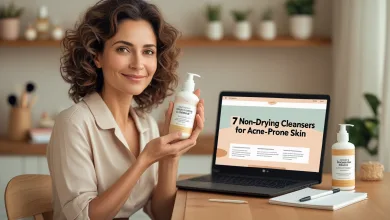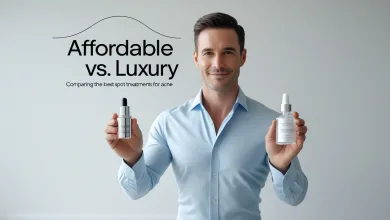Fungal Acne: How to Identify and Treat This Common Misdiagnosis


If you’ve been treating your persistent “acne” with traditional methods but seeing no improvement, you might be dealing with fungal acne instead. This comprehensive guide will help you identify and effectively treat this commonly misdiagnosed skin condition.
Understanding Fungal Acne: Not Your Regular Breakout
You’ve probably been there – diligently following your skincare routine, using all the right acne-fighting ingredients, yet those stubborn bumps just won’t go away. What gives? Well, there’s a good chance what you’re dealing with isn’t acne at all. Fungal acne, medically known as Malassezia folliculitis or pityrosporum folliculitis, is a common skin condition that’s frequently misdiagnosed as regular acne.
Unlike traditional acne (acne vulgaris) which is caused by bacteria, fungal acne is triggered by an overgrowth of yeast that naturally lives on your skin. This yeast belongs to the Malassezia family, and when it grows out of control, it leads to inflammation of the hair follicles, creating small, uniform, itchy bumps that closely resemble regular acne. The tricky part? Since it looks so similar to bacterial acne, it’s often treated with the wrong products, which can actually make the condition worse!
How to Spot Fungal Acne: Key Differences from Regular Breakouts
If you’ve been battling what you thought was acne but aren’t seeing results from traditional treatments, it might be time to reconsider your diagnosis. Fungal acne has several distinctive characteristics that set it apart from bacterial acne.
First off, fungal acne tends to appear as uniform, same-sized bumps, typically smaller than regular acne. These bumps are often clustered together in areas rich in oil glands like the forehead, chest, upper back, and shoulders. Unlike traditional acne, which can vary in size and type (think whiteheads, blackheads, pustules, etc.), fungal acne presents more consistently. Another dead giveaway? Itchiness! Regular acne usually isn’t itchy, but fungal acne often comes with a significant itch factor.
When examining your skin, pay attention to how the bumps are distributed. Fungal acne typically appears in clusters of small, uniform pustules, while bacterial acne is more scattered and varied in appearance. If you’ve been using traditional acne treatments for weeks with no improvement—or worse, if your condition seems to be getting worse—that’s another sign you might be dealing with fungal acne instead.
Common Triggers: Why You Might Be Experiencing Fungal Acne
So, what causes this pesky yeast to go into overdrive? There are several factors that can trigger a fungal acne outbreak. Understanding these triggers can help you not only treat but also prevent future flare-ups.
Hot, humid environments create the perfect breeding ground for Malassezia. That’s why fungal acne often flares up during summer months or in tropical climates. If you’re hitting the gym regularly, those sweaty workout sessions could be contributing to your fungal acne woes. The yeast thrives in warm, moist conditions, making post-workout skin a prime target.
Your wardrobe choices might also be playing a role. Tight, non-breathable clothing traps heat and moisture against your skin, creating ideal conditions for yeast overgrowth. Similarly, staying in sweaty clothes after exercising can exacerbate the problem. And if you’ve recently completed a course of antibiotics, you might notice a fungal acne flare-up. This happens because antibiotics reduce bacteria on your skin, which can disrupt the normal balance of microorganisms and allow yeast to flourish.
Other common triggers include:
- Compromised immune system
- Hormonal changes or imbalances
- Excessive oil production on the skin
- Use of occlusive skincare products or makeup
- Dietary factors (high sugar or yeast consumption)
- Certain medications like corticosteroids
The Diagnosis Dilemma: Why Fungal Acne Is Often Misidentified
Let’s face it—when most of us see bumps on our skin, we immediately assume it’s acne and reach for traditional acne treatments. This is exactly why fungal acne is so commonly misdiagnosed, even by healthcare professionals who might not be specialists in dermatology.
The visual similarity between fungal acne and bacterial acne is the main culprit behind misdiagnosis. Both conditions can present as small red bumps on the skin. However, using traditional acne treatments on fungal acne can actually make things worse! Ingredients like benzoyl peroxide and certain antibiotics target bacteria but do nothing against yeast—in fact, they might disrupt your skin’s microbiome further and allow the yeast to thrive even more.
Another complicating factor is that some people experience both types of acne simultaneously, making diagnosis even trickier. If you suspect you have fungal acne, it’s worth consulting with a dermatologist who can perform specific tests to confirm the diagnosis. These might include examining skin scrapings under a microscope or using special lights to identify the yeast.
Effective Treatment Strategies for Fungal Acne
Now that you’ve identified that fungal acne might be your actual problem, it’s time to tackle it effectively. The good news? With the right approach, fungal acne is typically very treatable.
Antifungal Treatments: Your First Line of Defense
Since fungal acne is caused by yeast, not bacteria, antifungal treatments are your best bet for clearing it up. Over-the-counter options include antifungal creams, shampoos, and body washes containing ingredients like ketoconazole, selenium sulfide, or pyrithione zinc. These products work by directly targeting and killing the yeast that’s causing your breakouts.
For example, many people have success using dandruff shampoos like Nizoral (which contains ketoconazole) as a mask on affected areas. Apply it to dry skin, leave it on for about 5 minutes, then rinse off. You can do this a few times a week as part of your treatment routine. For more severe or persistent cases, your dermatologist might prescribe oral antifungal medications like fluconazole or itraconazole.
Skincare Routine Adjustments: What to Avoid and What to Embrace
Your everyday skincare routine requires some tweaking when dealing with fungal acne. The yeast that causes fungal acne feeds on oils, so you’ll want to avoid heavy, oil-based products. Look for non-comedogenic, oil-free, and “fungal acne-safe” products that won’t feed the yeast.
Ingredients to avoid include:
- Most oils (especially olive, coconut, and other plant oils)
- Fatty acids like stearic acid
- Esters (ingredients ending in -ate)
- Polysorbates
- Ferments
Instead, focus on gentle, non-feeding ingredients like:
- Squalane (not to be confused with squalene)
- Mineral oil (though this may not work for everyone)
- Simple alcohols
- Most silicones
- Aloe vera
- Hyaluronic acid
Exfoliation can also help manage fungal acne, but choose chemical exfoliants like salicylic acid rather than harsh physical scrubs that might irritate the skin further. Salicylic acid is oil-soluble and can penetrate into the hair follicles, helping to clear out excess oils that might be feeding the yeast.
Lifestyle Changes to Prevent Recurrence
Treating existing fungal acne is just half the battle—preventing it from coming back is equally important. By making a few simple lifestyle adjustments, you can significantly reduce your risk of recurrence.
First things first, consider your workout routine. While exercise is undoubtedly good for your overall health, staying in sweaty clothes after a workout is a recipe for fungal acne disaster. Always shower promptly after exercising, and if that’s not possible, at least change into clean, dry clothes. When showering, use antifungal body washes periodically as a preventative measure, especially in hot, humid weather.
Your wardrobe choices matter too. Opt for loose-fitting, breathable fabrics like cotton and linen, particularly in warm weather or during workouts. These fabrics allow your skin to breathe and prevent the trapped heat and moisture that yeast loves. It’s also a good idea to wash towels, pillowcases, and anything else that comes into regular contact with affected areas frequently and in hot water to kill any lingering yeast.
Diet might also play a role in managing fungal acne. Some people find that reducing sugar and simple carbohydrates helps control yeast overgrowth throughout the body. While the direct link between diet and fungal acne hasn’t been conclusively proven, many dermatologists acknowledge the potential connection between what you eat and how your skin behaves.
When to See a Dermatologist: Don’t Go It Alone
While mild cases of fungal acne can often be managed with over-the-counter treatments and lifestyle changes, there are times when professional help is necessary. If your symptoms don’t improve after a few weeks of self-treatment, or if they’re severe or causing significant discomfort, it’s time to book an appointment with a dermatologist.
A dermatologist can provide a definitive diagnosis through professional examination and, if necessary, tests like skin scrapings or biopsies. They can also prescribe stronger treatments that aren’t available over the counter, such as prescription-strength antifungal creams or oral medications. In cases where fungal acne is recurring or particularly stubborn, they might recommend a longer-term treatment plan or maintenance therapy to prevent future outbreaks.
Don’t hesitate to seek professional help if you’re unsure about your diagnosis or if your condition is causing physical discomfort or emotional distress. Remember, what looks like fungal acne could sometimes be another skin condition altogether, such as bacterial folliculitis, regular acne, or even a form of dermatitis.
Fungal Acne FAQs: Your Burning Questions Answered
Q: Can I use regular acne products while treating fungal acne?
A: It’s best to pause most regular acne treatments while addressing fungal acne, especially those containing oils or ingredients that might feed the yeast. However, some ingredients like salicylic acid can be helpful for both types of acne. Always check that products are “fungal acne safe” before using them.
Q: Is fungal acne contagious?
A: Fungal acne isn’t typically considered contagious in the way that something like ringworm is. The yeast that causes it is naturally present on everyone’s skin. However, the factors that cause it to overgrow—like excessive sweating or certain skincare products—aren’t transferred from person to person.
Q: How long does it take to clear up fungal acne?
A: With proper treatment, you should start seeing improvement within 1-2 weeks. Complete clearance might take 4-6 weeks, depending on the severity. Consistency with your treatment regimen is key!
Q: Can I wear makeup if I have fungal acne?
A: You can, but choose your products carefully. Look for non-comedogenic, oil-free foundations and makeup products that don’t contain fungal acne triggers like oils and esters. Mineral makeup is often a good option. Always remove makeup thoroughly before bed.
Q: Will fungal acne leave scars?
A: Fungal acne is less likely to cause scarring than traditional acne because it’s typically more superficial. However, if you pick or squeeze the bumps, you increase the risk of scarring and spreading the yeast to nearby areas.
Final Thoughts: Taking Control of Your Skin Health
Dealing with fungal acne can be frustrating, especially if you’ve been mistakenly treating it as regular acne without seeing results. But now that you’re armed with the knowledge to identify and treat this condition properly, you’re well on your way to clearer skin.
Remember, the key to successfully managing fungal acne lies in both proper treatment and prevention. Antifungal products, fungal-acne-safe skincare, and lifestyle adjustments work together to not only clear current breakouts but also prevent future ones. Patience and consistency are crucial—while you might start seeing improvements within days, complete resolution can take several weeks.
Don’t be discouraged if you experience occasional flare-ups, especially during hot, humid weather or stressful periods. With your newfound knowledge, you’ll be able to recognize the early signs and take prompt action before it becomes a major issue again. And if you’re ever in doubt, consulting with a dermatologist is always a wise choice.
Fungal acne may be a common misdiagnosis, but with the right approach, it doesn’t have to be a long-term skin problem. Here’s to healthier, clearer skin ahead!






